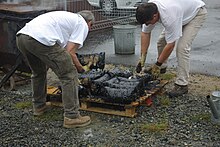
Summary
A gigot bitume (asphalt leg of lamb) is a leg of lamb prepared by wrapping the meat in kraft paper and placing it in a bath of hot asphalt. This preparation method is traditionally used in France to celebrate the completion of the structural portion of construction projects or public works.[1][2][3]

A recipe for the dish, gigot cuit dans le goudron, appears in the 1900 cookbook La Vraie cuisine pratique: Les potages, les poissons, le bœuf, le veau, l'agneau, le mouton, le porc, la volaille, le gibier ("True Practical Cuisine: Soups, Fish, Beef, Veal, Lamb, Mutton, Pork, Poultry, Game")
This is a strange cooking method that can be put to good use by workers. I give the recipe as it was passed on to me. In a hot boiler of asphalt, when paving the ground, immerse a leg of lamb wrapped in very strong paper. With the assistance of a stone attached to one end, it will be pulled into the middle of the tar. One hour of cooking gives the meat a particularly excellent flavor. Salt when removed from the heat.
Usage of this cooking method by asphalt workers, in particular, has existed since the end of the 19th century.
In Val-de-Travers in western Switzerland, a similar tradition exists where a ham is cooked in asphalt (Jambon cuit dans l’asphalte).[4]
References edit
- ^ Le « gigot bitume » achève le chantier, publié le 27 septembre 2013, ouest-france.fr.
- ^ Villejuif : le spécialiste du « gigot bitume » face aux caméras de Petitrenaud, publié le 16 décembre 2016, leparisien.fr.
- ^ Le gigot-bitume : la marque de fabrique du BTP, publié le 6 juillet 2011, lemoniteur.fr.
- ^ Heddi (26 August 2015). "Culinary Travel: Ham Cooked in Asphalt". CUISINE HELVETICA. Retrieved 5 February 2024.


